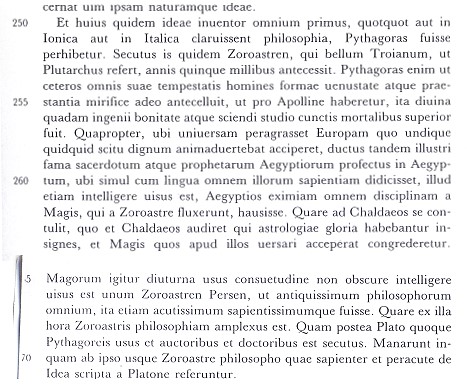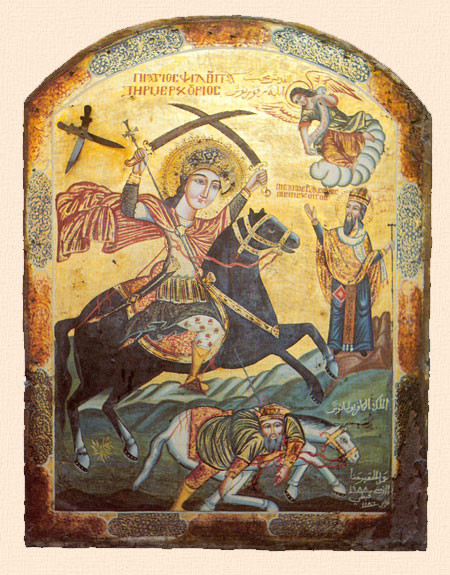Huck wrote,
Filelfo wrote only a longer letter and mentioned Zoroaster, as far I understand it.
Here is the passage from Filelfo, which I lifted from Ross’s earlier post. After that is Google’s translation, very garbled but perhaps you will get some sense out of it, until a better translation is available. Then I have a couple of actual quotes from Plethon, in English and Greek, for comparison:
Et huius quidem ideae inventor omnium primus, quotquot aut in Ionica aut in Italica claruissent philosophia, Pythagoras fuisse perhibetur. Secutus is quidem Zoroastren, qui bellum Troianum, ut Plutarchus refert, annis quinque millibus antecessit. Pythagoras enim ut caeteros omnis suae tempestatis, homines, formae venustate, atque praestantia mirifice adeo antecelluit, ut pro Appolline haberetur, ita divina quadam ingenii bonitate atque sciendi studio, cunctis mortalibus superior fuit. Quapropter ubi universam peragrasset Europam, quo undique, quicquid scitu dignum animadvertebat, acciperet, ductus tandem illustri fama sacerdotum, atque prophetarum, Aegyptiorum, profectus in Aegyptum, ubi simul cum lingua omnem illorum sapientiam didicisset, illud etiam intelligere visus est, Aegyptios eximiam omnem disciplinam a Magis, qui a Zoroastre fluxerunt, hausisse. Quare ad Chaldaeos se contulit, quo et Chaldaeos audiret qui astrologiae gloria habebantur insignes, et Magis quos apud illos versari acceperat congrederetur. Magorum igitur diuturna usus consuetudine non obscure intelligere visus est unum Zoroastren Persen, ut antiquissimum philosophorum omnium, ita etiam acutissimum, sapientissimumque fuisse. Quare ex illa hora, Zoroastris philosophiam amplexus est. Quam postea Plato quoque Pythagoreis usus et auctoribus et doctoribus est secutus. Manarunt in quam ab ipso usque Zoroastre philosopho, quae sapienter et peracute de Idea, scripta a Platone referuntur.
Google:
And this is for the inventor of ideas first of all, as many as, or in Italian or in claruissent Ionian philosophy, Pythagoras said to have been. Zoroastren he followed the war Trojan, as Plutarch relates, thousands of five years in advance. For all the rest of his storm as Pythagoras, men, the forms of beauty, and excellence are superior to so wonderfully, so that for Apollo should be, so the divine goodness, and of knowing a certain wit and zeal, and all mortals and the better one. Wherefore, where the whole of Europe and stores, which on every side, whatever worthy of observing knowledge, He should receive, at length, led by the illustrious reputation of the priests, and prophets, of the Egyptians, set out for Egypt, where at the same time with the language and knew all their wisdom, it was seen also to understand, all the Egyptians exceptional discipline from the Magi, who, from the Zoroastre gushed out, imbibed. Why he went to the Chaldeans, which he heard and the Chaldeans, who were distinguished for the glory of astrology, and more conversant with those whom he had received congrederetur. Magi, therefore, was seen for a long time to understand the use of custom is one Zoroastren Perses not obscurely, as the most ancient philosophers of all, so even the sharpest, sapientissimumque to have been. Wherefore from that hour, Zoroastris philosophy embraced. How authors and teachers, use, and after him Plato Pythagoras also followed. By him until Zoroastre Manarunt into which the Philosopher, which wisely and VERY SHARPLY of the Idea, written by Plato they are referred.
From an online Latin dictionary I get: Claruissent = related to “clarified”; Manarunt = flowed.
Now compare this to Plethon. Here are two pages from “Pletho’s Calendar and Liturgy,” by Milton V. Anastos, in
Dumbarton Oaks Papers 4 (1948), pp. 183-305. It is from Part II, “Pletho and Islam,” section VI, “Pletho and Zoroaster.” I post the actual pages because it has the Greek (for Ross).
http://1.bp.blogspot.com/-Dkg2_fWmBT4/TorEx_sVOdI/AAAAAAAADkk/98jvbjhLTLk/s1600/Anastos280.jpg
http://2.bp.blogspot.com/-egnAAI_groc/TorExyqq71I/AAAAAAAADks/aFko4bf9FHg/s1600/Anastos281.jpg
Anastos’ sentence at the bottom of p. 281 ends on p. 282 with “...the Magi.” The sentence has a footnote, #490 “Festugiere, op. Cit. (n. 482 supra), 20-44. That book is
La revelation d’Hermes Trismegiste, I, (Paris 1944).
When I compare these pages with what I think I see in Filelfo, and also with the Plutarch (Isis and Oriris 46-48) and Diogenes Laertius (Life of Pythagoras), I think I see the most similarities to Plethon. Certain phrases even seem to echo Plethon, like “the most ancient of all the philosophers” and “Plutarch says that Zoroaster...is represented as antedating the Trojan War by 5,000 years” or “Zoroaster lived 5000 years before the Trojan War” (although this phrasing is in Plutarch, too).
What I want to focus on in particular is Filelfo's attribution of Plato's theory of Forms to Zoroaster, which I think is in Filelfo's last sentence, and which Hankins repeats when he says, paraphrasing Filelfo
Even Plato's doctrine of the Ideas had been borrowed from Pythagoras who was himself following Zoroaster and the Chaldean mages.
The idea that the theory of Ideas can be traced back to Zoroaster is not in the passages from Plethon that Anastos quotes. The Platonic theory of Forms (Ideas in Greek) is, however, attributed to the Oracles in both Plethon's “Brief Explanation” and “Commentary” on the Oracles, e.g.
They call ‘spells’ (l. 55) the intellects linked to him and the separated Forms, which they also call the ‘inflexible upholders of the world’ (l. 57) (Woodhouse p. 53).
(The word Woodhouse translates by "spell" is the Greek "iynx.") And in the "Commentary," Woodhouse has the following in his mixture of quotes and paraphrase (p. 58):
The Father 'perfected everything' (l. 53), that is, he created the intelligible Forms, which he entrusted to the second god to rule over. ...The 'mental spells' (l. 55) are the intelligible Forms, 'conceived b the Father and themselves conceiving and moved towards conceptions by unspoken and voiceless wills'. The latter phrase means 'unmoved wills', for by movement is meant 'simply an intellectual relationship', and 'to speak' is taken to be a kind of motion. So what is meant is 'unmoved Forms'. The supreme intelligible Forms are called the 'upholders of the universe' (l. 57), and chief among them is the second god. In calling them 'inflexible', the Oracle has in mind the immortality of the Universe.
The question is, does Plethon anywhere else attribute the Platonic Forms or Ideas to Zoroaster? If not, then Filelfo is probably drawing on the "Brief Explanation" or "Commentary" for his own attribution of Plato's doctrine of Ideas to Zoroaster, as buttressed by what Plethon takes to be an actual Zoroastrian source.
Woodhouse has a whole chapter on the "Reply to Scholarios," which he says (p. 308) was probably completed in 1449. Scholarios himself first got it from others, so apparently it circulated among the Greek community. Woodhouse's presentation, like that of the "Commentary," is a mixture of quotes and paraphrases. Among the quotes we have (p. 284f)
the surviving oracles of Zoroaster are clearly consistent with the doctrines of Plato, totally and in every respect.
But this is not the same as saying that Zoroaster held the doctrine of Ideas. In fact, nowhere in the "Reply" is the doctrine of Ideas attributed to Zoroaster. Nor is it in the "De Differentiis", which Woodhouse translates in full. Plethon does attribute the doctrine of Ideas to Timaeus of Locris, a Pythagorean, in both places (based on a text that was actually written after Plato, according to modern scholars). But that is as far back as Plethon goes. Nor does Woodhouse mention Plethon talking about Zoroaster or Zoroastrians or Magi as holding the doctrine of Ideas anywhere else; I checked every reference to Zoroaster in Woodhouse's index. So it seems to me that Filelfo at least saw Plethon's Brief Explanation or Commentary, enough so that this point made an impression, even if he didn't have a copy personally. If he saw one of those, he probably also saw Plethon's Oracles themselves, which back up Plethon's attribution; that would probably have satisfied Filelfo that Plethon was on firm ground.
Now I will turn to another part of Huck's speculations. (Well, the first was actually Ross's, but Huck accepted it. I am not against speculations, let me make clear; until we have a translation of Filelfo, there is an element of speculation in what I am saying, too.)
Part II of Anastos’ monograph studies the question of Plethon and Islam exhaustively and finds nothing resembling anything Islamic in Plethon’s writings, with which Anastos seems thoroughly familiar. He also quotes a sizable chunk of the first of two letters by Scholarios, the source for the mysterious Elisaeus. Here is the page of Anastos that starts with a lengthy quote from the first letter.
http://4.bp.blogspot.com/-0DD8HmOvEYg/TorRd5G89QI/AAAAAAAADk0/9nnR3JR71Kk/s1600/Anastos278.jpg
Anastos does not quote from the second letter, saying merely that it repeats the charges relating to Elisaeus. Woodhouse mentions that the second letter has one additional thing, that Elisaeus met his just end, being burned at the stake.
From the amount of detail in Scholarios’s account, and the Aristotelian leanings of this Elisaeus, I would think that Plethon would not have been making a joke about Elijah, and that Scholarios probably had this information before either of them ever saw Italy, unless Scholarios was fabricating it. But Plethon himself says, in the "Reply," that he learned about Averroes from "certain Jews." Here is Woodhouse's paraphrase (p. 284f). The part in quotes means he is directly quoting from Plethon:
I too learned of Averroes' views on the human soul from 'the better Italian philosophers and certain Jews';...
Also, I found some support of Huck's speculation that Ficino got his copy of Plethon's edition of the Oracles from Cosimo. D. P. Walker, in his book
Spiritual and Demonic Magic From Ficino to Campanella argues that Ficino's interest in the Orphic Hymns was stimulated indirectly by Plethon. Plethon doesn't mention the Orphic Hymns anywhere, he says, but his own hymns are structurally similar and also are directed at Greek pagan deities. Moreover,
The theory of prayer with which Pletho introduces his hymns is remarkably like the theory of magic behind astrological music.
Walker then quotes from Pletho (I can give it if anyone wishes) and goes on to say
Pletho's hymns and rites, like Ficino's, do not aim at any objective effect on the deity addressed, but only at a subjective transformation of the worshipper, particularly his imagination.
Walker then speculates that the interest in the hymns, which he translated in 1462, came from Cosimo. Cosimo especially requested on his deathbed that Ficino bring his lyre, as I recall. Walker concludes (p. 63):
The transmission need not necessarily have been thorugh any writing of Pletho's, but may have been through Cosimo and other Florentines who listened to Pletho during the Council of Florence.
If the Orphic Hymns, in memory and spirit, why not also the Chaldean Oracles, in writing?
Another possibility is that Ficino may have had his interest in the Hymns (and maybe even the Oracles) stimulated by his Greek teacher in these years, John Argyropoulos (
http://en.wikipedia.org/wiki/John_Argyropoulos) who George Holmes in
The Florentine Enlightenment speculates was a follower of Plethon. He had been an emissary of the Despot of the Peloponnese (unfortunately this is all from memory, as I copied the wrong page at the library). But Plethon wrote an attack on him later for adopting the Latin rite, according to Woodhouse; and his translations are all of Aristotle. Cosimo is more likely.
Plethon's influence on the tarot via the Orphica is a topic we haven't looked into. I don't know if the Orphica's relationship to the tarot has been pursued. I see some possible connection between the "Phanes" material (
http://www.theoi.com/Protogenos/Phanes.html) and the Marseille World card, and between the Hymn to Mnemosyne and the Cary Sheet and Marseille Star cards. That's probably a topic for later.





